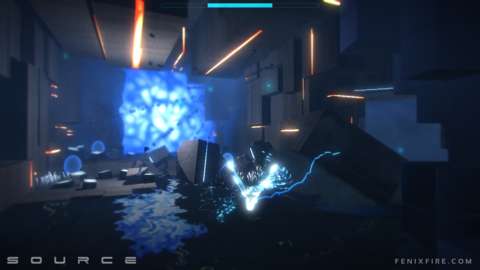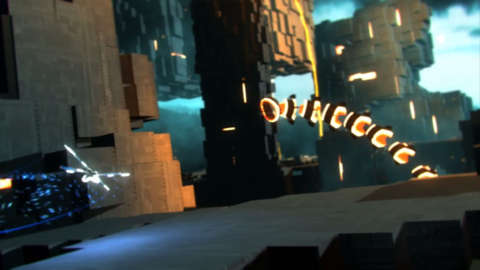"We just had our first son born nine months ago." Brian McRae--one of the two-person, husband-and-wife team designing the upcoming PlayStation 4, Xbox One, and PC adventure Source at FenixFire--explains the inspiration behind the alien landscape that stretches before us. "When a baby is born, they don't know what the world is supposed to look like. It's a strange thing. They're just grabbing stuff. Is this edible? What does this do? Is this dangerous? Helpful? Harmful? And we wanted to bring that infant-eyes aspect to this game." I can see that sense of wonder manifest in Source, as the bioluminescent firefly ventures across this dreamlike environment. However, that feeling of awe extends beyond the confines of the game. McRae and his wife, Anna Gambal-McRae, have jumped from the predictability of AAA development into the rocky waters of the indie scene, and they're learning how to stay afloat in this unexplored world.
"[Source] is all about this exchange of energy," McRae explains. The energy pulses off you, creating a blue aura around the firefly you use to explore this strange land. Lightning bolts shoot from your body. You move boxes with these bursts, corral glowing keys, power dormant cocoons, and fry pesky enemy threats. Seeing the dazzling lights sparkle in the gloomy morass of the unknown is a beautiful sight, so much so that I was mesmerized as McRae soared over geometric outcroppings, darting above the docile, insect-like fauna.
"You're always losing energy as you fly around. You lose energy as you shoot, as you jump, as you speedburst. Just like any living creature in real life, right? We all need food, oxygen, all this kind of stuff to survive," McRae says. There's only one piece of information onscreen, a lone bar that keeps track of how much energy your firefly still has. The rest is filled with the alien splendor of this world. "In most games, you're the big guy with the big gun just mowing down lots of guys, and the way to balance that and make it difficult is to just have more waves of creatures coming in and shooting," he notes. "[But in Source], you're battling against survival." It's a marked shift from what's expected. There are puzzles to solve and enemies to kill, but every act you take weakens your firefly. You're just treading water--searching for more power--doing whatever you can before your energy runs dry.
McRae and his wife have jumped from the predictability of AAA development into the rocky waters of the indie scene, and they're learning how to stay afloat in this unexplored world.
The goal of McRae and Gambal-McRae is to "make things look familiar and yet unfamiliar at the same time." I can see this intent in how strange Source looks, how it aligns common shapes in uncommon patterns to skew your sense of normalcy. And that unfamiliarity has pushed Source into a realm in which going the independent route was the only chance of seeing this through to completion. "It's kind of off the beaten path, and it's something that a publisher would have no business doing," McRae says. "This isn't either a sexy girl or a big guy with a gun. You actually have to think about it a little bit." But even if a big publisher had shown interest, McRae would have had reservations working with the company. "I'm a little wary of publishers. I've worked with a publisher before and had a terrible go of it."

McRae wasn't always in this position. Source is a "dream project" for McRae and Gambal-McRae, a drastic change from where they once were. "I used to work at Blizzard. I was the lead environment artist for StarCraft: Ghost," he says. "She's an environment artist as well. She worked at The Collective on Silent Hill: Homecoming, GI Joe, and Front Mission." So they've gone through the grind of developing highly scrutinized games with big budgets, and they appreciate the intimate control they have over Source. "Now we don't have to have a meeting to talk about whether we're going to do something. We just go and put it in because we're a small team and we can do it."
Being on your own is liberating, but it's also scary when you don't have a lifeboat to save you from treacherous waters. "I'm extremely terrified," McRae responds when asked what it felt like to show an unfinished version of his game. "But we just showed this at PAX; we got a lot of great reception from that. We submitted to Steam Greenlight five days ago, and then yesterday just got green-lit. We have a 62 percent yes vote." So things are going smoothly in one regard. People who have seen the game are excited by the prospect of exploring this fantastical world. That doesn't mean it has been easy to put Source together, though. People need money to make games, and all the positive reception in the world doesn't matter if there's no funding. "We're doing a Kickstarter that's failing miserably at the moment. If it happens, great. If not, it's not going to stop us. We're going to keep going."
Life gets in the way of development. "We're only four months in. We're a two-person team--a husband-and-wife team--and we're doing this nights and weekends. We're self-funding this stuff right now." When they're not working on Source, they're doing contract work developing software for clients. They worked with the Oculus Rift, for instance, when the virtual reality headset was still in its infancy, designing a demonstration in which you explore a house called Tuscany World. So they do have steady work, though every project that pours money into the household demands time and energy that could have been spent working on Source. It's a tough balancing act--getting funding while trying to realize your dream--and one that is only becoming more complicated now that they have a child to care for.

"Now my wife can't work on the game as much, only when he's sleeping, so it's been a little tough," McRae explains. "It might be nice if we could get some kind of funding so we could hire a babysitter." It's the reality of being independent. Now that McRae and Gambal-McRae can finally create their dream project, can implement whatever they want without meetings or approval from higher-ups, they have run into a wall that holds so many people back. Reality can get in the way of realizing one's vision, and they're pushing through together to figure out a way to care for their child, create software for clients, and bring Source to life. It's not an easy situation for anyone.
But McRae is not deterred. "I think video games are the ultimate art form. You have the visuals; you have audio. You're playing with time, you're playing with animation, and you're playing with interactivity. There's no other art form that encompasses all of those aspects all together. And the sky's the limit with what it is you want to do, show, and express." So they're going to keep working. "It's a personal game, very artistic game. We're both artists, we want to express, and that's what this game's about."